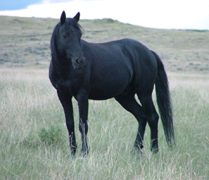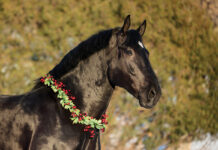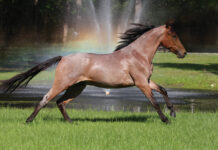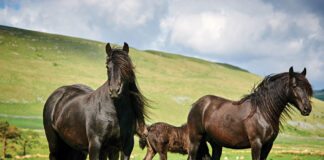Country of Origin: Iberian Peninsula
Color: Bay, black, chestnut and white are common colors. Pinto and Appaloosa markings are also found.
Height: 13.2 to 15 hands
|
Profile: The Spanish Mustang is a descendent of horses brought to the New World by the Spaniards in the 15th century, starting with Columbus’ second journey. Breeding farms were established, and through trade and the settlement of new land, these Spanish horses eventually spread throughout North America. Horses that escaped domestication and those that were lost or stolen developed feral herds, in which only the strongest horses survived. They were later given the name “mesteno,” a Spanish word that roughly translates as “feral” or “wild.” Over time, the Spanish Mustang’s numbers grew, and it was the most common type of horse until the 1800s when further domestication and crossbreeding took their toll.
In the 1920s, Wyoming rancher Bob Brislawn, who regularly worked with Spanish Mustangs, realized that the qualities of the original type were disappearing. He later acquired two stallions from a feral herd and began breeding them to his mares. In 1957, he established the Spanish Mustang Registry, the first and oldest Mustang registry in the country.
The Spanish Mustang is not to be confused with the Mustangs managed by the Bureau of Land Management (BLM). Although the two horses have similar qualities because of their Spanish ancestry, the Spanish Mustang has been selectively bred to maintain the most original qualities of its predecessors.
Characteristics: Spanish Mustangs have small to medium ears and a straight or concave forehead with a convex nose. Fairly pronounced withers lead to a short back, rounded rump and a low-set tail. The cannon bones are short and larger in circumference than in other breeds. The hooves are sound and have thick walls. Many Spanish Mustangs are gaited.
For more information, contact the following organizations:
Spanish Mustang Registry, /redirect.php?location=http%3a%2f%2fwww.spanishmustang.org%2f
Horse of the Americas, /redirect.php?location=http%3a%2f%2fwww.horseoftheamericas.com%2f
Windcross Conservancy, /redirect.php?location=http%3a%2f%2fwww.sorraiamustangs.org%2f
American Heritage Horse, /redirect.php?location=http%3a%2f%2fwww.americanheritagehorse.org%2f
Spanish Mustang Researchers Facility, www.smresearchersfacility.com/smrf
American Livestock Breed Conservancy, www.albc-usa.org






